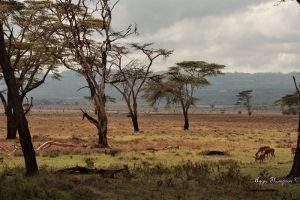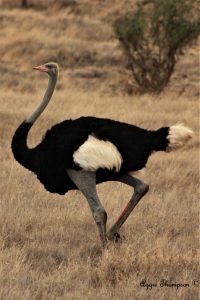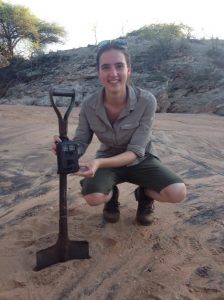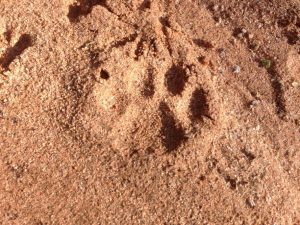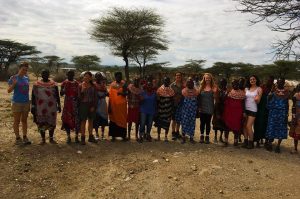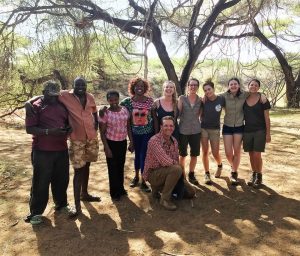Back in November, the five of us visited Kenya for the MRes field course. The aim of the trip was to study a number of field techniques and compare the different conservation management strategies used at two conservancies, Lewa Wildlife Conservancy and Westgate Community Conservancy.
First, we visited Lewa Wildlife Conservancy where we stayed for five nights.
As soon as we pulled off the main road into Lewa we were greeted by wildlife, including wonderful views of reticulated giraffes (Giraffa reticulate) and Grevy’s zebra (Equus grevyi). We later went for a short game drive and saw black (Diceros bicornis) and white rhinoceros (Ceratotherium simum), buffalo (Syncerus caffer), elephant (Loxodonta africana), waterbuck (Kobus ellipsiprymnus), impala (Aepyceros melampus), and Grant’s gazelle (Nanger granti), to name just a few!
- Buffalo (Syncerus caffer)
- Ostrich sp. (Struthio sp.)
Unfortunately, our first full day on Lewa was affected by bad weather – a result of the microclimate around Mount Kenya in which Lewa is situated.
We did, however, get out on a short game drive in the afternoon where we learnt how to undertake distance sampling and practiced on ungulate species such as impala, plains zebra (Equus quagga) and waterbuck.
Day two on Lewa was spent honing our newly learnt skills of distance sampling with Beisa oryx (Oryx gazelle), Grant’s gazelle and warthogs (Phacochoerus africanus). This was followed by a talk on the security measures that are in place on Lewa, which was very informative but strictly confidential! Later that day we had a session delivered by one of the onsite conservation biologists on how to sample spotted hyena (Crocuta crocuta) scat. By analysing the bits of hair and bone that the scat contains you can determine what the hyena has been feeding on.
- Victoria
- Beth setting up a camera trap
During our time on Lewa we were also introduced to Foal Patrol, a regular census of the Grevy’s zebra population on the Conservancy. This was particularly interesting as we were able to see how the software used to identify individual zebras works. The patterns of each zebra act like a barcode which the software (IBEIS) picks up and uses to ID each individual.
- Aggie and Victoria identifying zebra
- Grevy’s zebra (Equus grevyi)
Day six came around all too quickly and although we were sad to leave Lewa, we were excited to visit somewhere new: Westgate Community Conservancy, situated a couple of hours to the north of Lewa. The landscape here was noticeably much drier and hotter!#
On our journey to Westgate we drove through Samburu National Reserve and were treated to a close up view of a herd of elephants and a young male lion (Panthera leo), our first carnivore sighted on the trip!
Whilst at Westgate, we were able to watch how scouts are trained to use an app called CyberTracker, which is used to collect data for Grevy’s zebra conservation (more information on this app can be found here: https://www.cybertracker.org/). We had first been introduced to this app in the classroom back in the UK so it was great to see how it is actually applied in the field. It was wonderful to meet the team as well and to witness the work that they are doing to help conserve this endangered species.
Other activities during our stay included learning vegetation sampling techniques and an introduction to spoor analysis, using tracks to identify what animals had passed by our camp. We were all surprised by how many species had passed so close to where we had been sleeping the night before! Animal tracks we saw included: African civet (Civettictis civetta), warthog, dik dik sp. (Madoque sp.), antelope sp., gazelle sp., genet sp. (Genetta sp.), ground squirrel sp. (Xerus sp.), helmeted guinea fowl (Numida meleagris), baboon sp.(Papio sp.), and most amazingly a leopard (Panthera pardus pardus)!
As we are an all girl cohort this year, on our last night we were invited to stay at Unity Women’s Village, where we were welcomed into their community with a cup of tea and a chat about the lives the women have built for themselves there. We enjoyed the local food that the women cooked for us as well as our morning bucket showers! We all slept on the floor of the main boma which was a bit of a tight squeeze but a great experience. You can read more about the village here: https://unitywomensvillage.wordpress.com/home/.
We were sad to leave on the final day but were glad that we no longer needed to carry out regular checks for scorpions in our shoes and tents! On the way back to the airport we were treated to a lovely lunch in a treetop restaurant and enjoyed the drive back through bustling Nairobi. The excitement continued at the airport where we had a frantic repack of all our gear and a surprising celebrity encounter with Tom Hiddleston!
Our 10 days in Kenya were jam-packed with learning and experiences and we all returned home ready to tackle the remainder of semester one and keen to get stuck into our fieldwork!
Written by Aggie, Beth and Victoria
Posted By : Danielle Free
